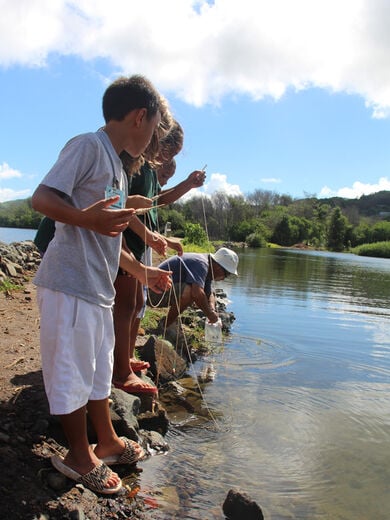
The Hawaiian Way
To perpetuate their students’ “living culture,” teachers in Hawai‘i must learn it, first.
Hawai‘i is one of six regions in Teach For America’s Native Alliance Initiative (the others are Oklahoma, South Dakota, New Mexico, Washington State, and the Twin Cities), where staff and corps members deepen their understanding and incorporation of indigenous culture and partnership-building each year.
Hawai‘i Teacher Standards require teachers to study Hawaiian culture and history in order to earn their certification. The regional team has worked to diversify its corps to better reflect the state’s uniquely multicultural student body, including Asian American and Pacific Islander students. In tandem with its recruitment efforts, the region partners with Teach For America’s admissions team to ensure that potential corps members can express their strengths in a culturally respectful manner. For example, strong leaders might credit their achievements to their families and communities. In contrast to focusing on individuals, “Native Hawaiian culture values the good of the collective and the group,” says the region’s executive director, Jill Baldemor (N.Y. ’95). “So leaders might not be the first in the group to talk. They might listen and lead from behind.”

Second-year corps member Kameleonalani Cleveland walks that walk. She teaches eighth grade English and history in the coastal area of Wai‘anae on Oahu, home to many indigenous families. In a long conversation about how her blended Cantonese and Native Hawaiian family upbringing influenced her teaching, she kept changing the subject to her students. “Whenever I introduce a concept,” she says, “my scholars come up with such wonderful inquiries that I learn from them. They are the ones who have molded my teaching. I’m merely a guide to what they wish to learn and become.”
In teaching, Cleveland says, she’s acting on the responsibility passed down by her parents to “perpetuate our living culture” by helping her students translate learning into actions that better their community. That includes a recent effort her class organized to clean up the beach at Poka‘i Bay. “It’s a life skill,” she says. “We don’t just learn in the four walls of the classroom, we learn together by doing.”

Having studied the Hawaiian language in college, Cleveland weaves it into lessons and into the mission statement for her class: Hui ka wa‘a, E po‘okela kākou na mea a pau. It means the group commits to striving for excellence in all they do so they can reach this goal: “We move as one.” (Editor’s Note: This article ran in the Fall 2014 edition.)
Sign up to receive articles like this in your inbox!
Thanks for signing up!
Content is loading...


